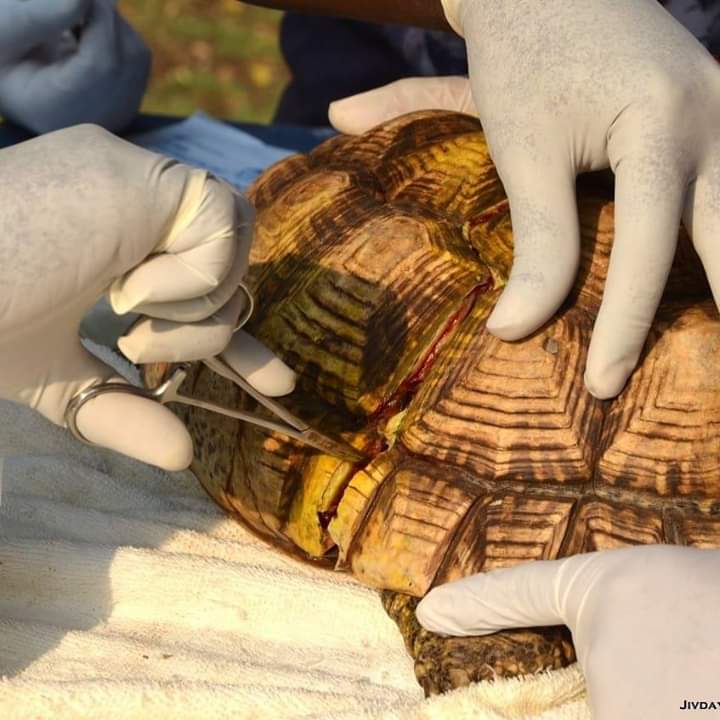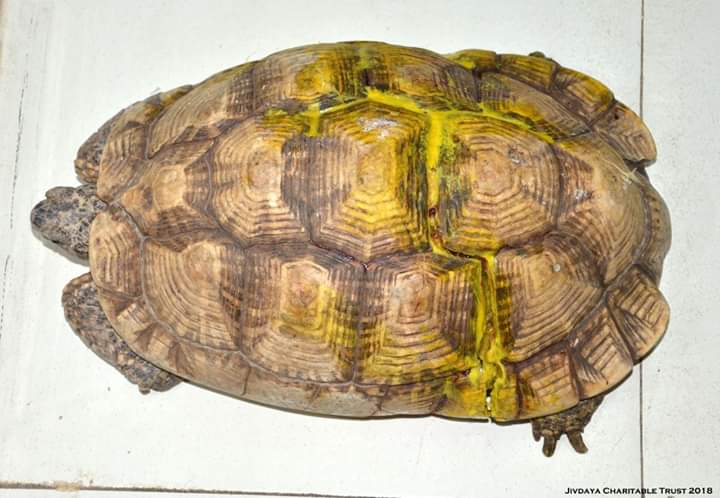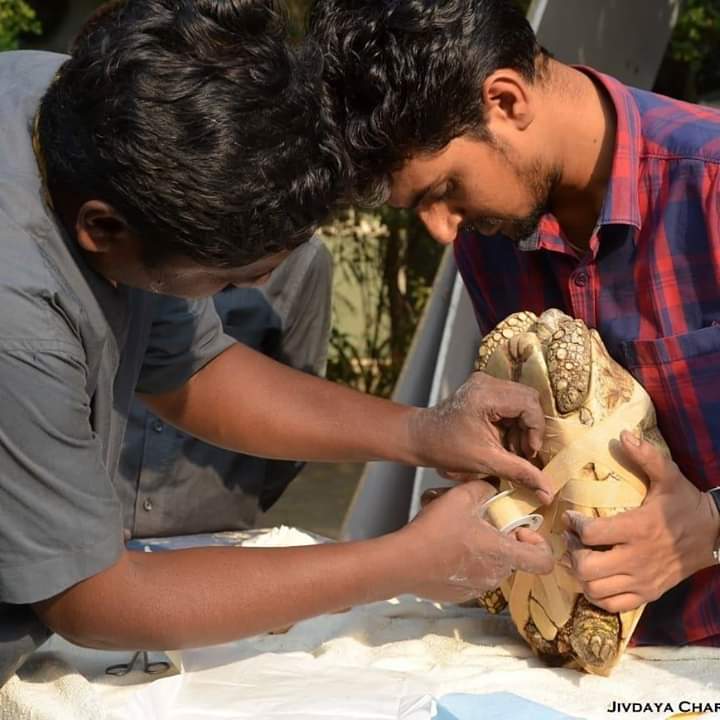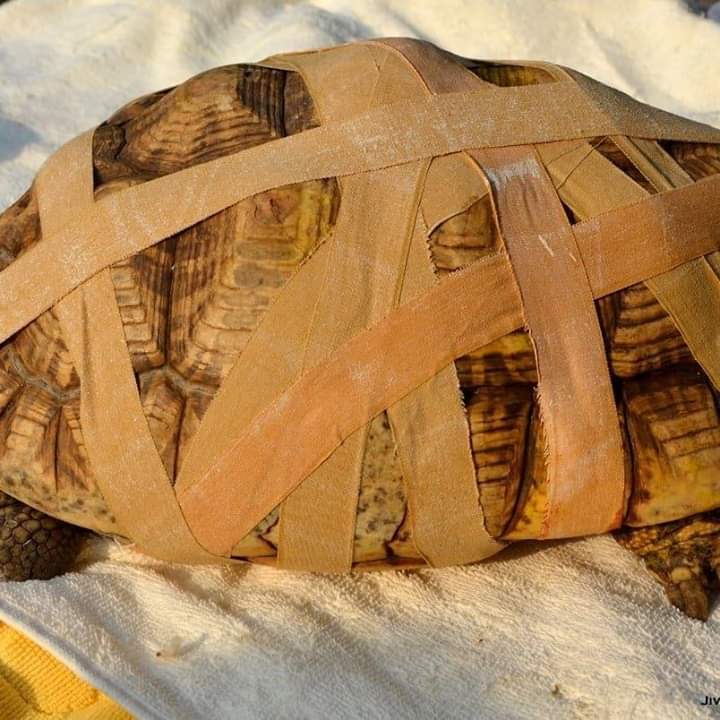Star Tortoise With a Broken Carapace

One of the basic lessons we received in school as a part of environmental education was where different kinds of animals lived. One creature that stood out from the rest was the tortoise. Along with its aquaphile cousin-the turtle- this unique reptile carries its home wherever it goes (other examples are snails and crabs). Corona pandemic has made the human race seek shelter in its homes. While people willingly or grudgingly started adapting to the new normal, one eternal truth shone brightly on all of us- the safety of a home is unparalleled. It is said, ‘home is where the heart is’. However, a virus changed it into, ‘home is where the HEALTH is’.
Now, it seems, we can appreciate just how privileged the tortoise really is. It doesn’t need to worry about going too far from the burrow or about a predator lurking in the bush… at the slightest hint of danger, it can sneak into the fortress on its back in the blink of an eye! It walks slowly, but where is the need to make haste? Also, it has a fairly long lifespan. That is one leisurely life!
The tortoise has a thick, hard and bulky shell which covers a soft body. The Indian Star Tortoise gets its name from the distinctive patterns on the shell. It is black in colour with several yellow streaks emanating from yellow areoles scattered all over. This patterning helps it camouflage in grass or vegetation. The shell, known as ‘carapace’, has humps on it and is convex in shape. The diet comprises of leaves, grass, fruits etc. They are found in Indian subcontinent in semi-arid regions. They act as natural dispersal agents of many plants by the consumption of seeds and fruits. Without them, vegetation will flow unchecked leading to a vicious imbalance in nature.

India Star Tortoise is a marvel of nature. Its humped shape is an inspiration for bio engineers who have studied its unique shape and utility. Imagine if you place this tortoise upside-down. How can it get back given its short limbs? This can be a life-threatening situation in the wild. The domed carapace of such short-limbed tortoises has only one stable position. Thus, like a round bottomed toy, which is centred at the bottom, the tortoise will be able to get back into its natural position by generating some momentum with limbs. In contrast, the turtles and tortoises with flatter and/or rounder shells have longer limbs which they use to get upright. The nature offers an unhindered access to knowledge and insight that is still a mystery to us. All we need is to LOOK!
Due to its hard shell, Indian Star Tortoise has barely any natural predator. Yet, this species has been given the status of ‘threatened’ by International Union of Conservation of Nature (IUCN). This means that if the threats to the survival of this species are not contained, it will become ‘endangered’. Illegal wildlife trade is its biggest challenge. Due to the stunning patterns on the carapace, the poor little tortoise becomes the victim of hunting and is inhumanely transferred through the international exotic pet trade. Some people belonging to the poor and uneducated strata of Indian society consume its soft meat.

Keeping this attractive animal as a pet is an offence and liable to prosecution. Some people get them due to superstitious beliefs that the presence of this tortoise in the house shall bring fortune and wealth. Like every other blind faith, this is dangerous, not just for the mute soul but also the people who will be apprehended by the law sooner or later.
We received this gorgeous aged Star Tortoise with a severe shell fracture. It had fallen down a flight of stairs inside the house. This poor tortoise had been kept as a pet for the last 4 years after she was kidnapped while crossing a highway. The “owners” felt bad for it after it fractured its shell and decided to hand it over to us for treatment and care.

The fracture was severe and had spread across to the hind portion of the shell, nearly separating it from the larger front half. The wound was cleaned and flushed with antibiotics. Our expert vet, Dr. Shashi, decided to opt for a non-intrusive shell repair. After debriding the wound, we taped up the shell from all sides. This way it gives the inner membrane a chance to heal itself to protect the internal organs. Due to the extent of the damage, more effective treatments like ‘pinning’ were out of the question. The outer crack will take at least a year to heal completely. However, the tortoise has started crawling about, basking in the sun and eating normally now. Looking forward to her recovery! As the saying goes, ‘slow but steady wins the race’; and who better than a tortoise would know that!
JCT APPEALS TO ONE AND ALL THAT KEEPING SUCH CREATURES IS AGAINST THE LAW AND MORALLY UNETHICAL. THESE CREATURES NEED THEIR NATURAL HABITAT, WITHOUT WHICH THEY WILL BE IN MENTAL STRESS. IT IS ALSO A PUNISHABLE OFFENCE. PLEASE DON’T LET BLIND FAITH RUIN INNOCENT LIVES AND THE ENVIRONMENT AT LARGE.







